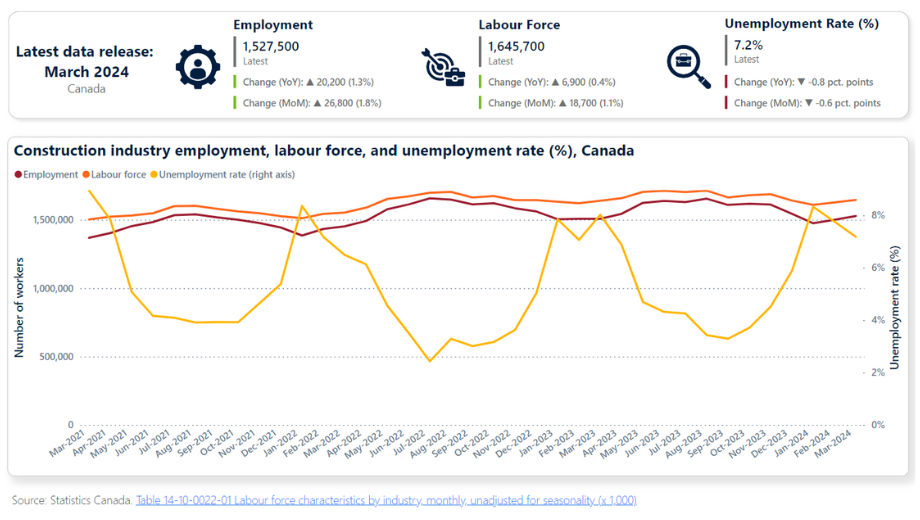Construction’s unemployment rate shrank in March, with employment growing faster than the labour force in eight provinces.
The latest data from Statistics Canada’s Labour Force Survey (LFS), from March 2024, finds that construction employment increased by 20,200 workers (1.3%) over the past 12 months, while the labour force added 6,900 workers (0.4%). As a result, the industry’s unemployment rate declined from 8% in March 2023 to 7.2% in March 2024.

Across the provinces, only British Columbia (-7.1%) and Saskatchewan (-10.3%) reported employment contractions in the past 12 months. These were likely due to the winding down and completion of major projects in both regions.
Alberta, meanwhile, reported a 9.5% increase in annual employment growth, the largest of all provinces. The increase was driven by growth in the province’s residential sector as well as strong demands from the heavy industrial maintenance sector, and ongoing work on large transit and industrial projects in Edmonton and Calgary.
Employment gains were also recorded in other provinces, such as a 4% increase in Quebec, a 21.7% increase in New Brunswick, and a 2.5% increase in Manitoba. All other provinces reported employment gains of fewer than 1,000 workers.
Year-over-year changes across the provincial labour forces – those employed and unemployed – follow mostly similar patterns. British Columbia reported a contraction of 7.6% in its labour force over the past 12 months and Saskatchewan a contraction of 1.4%. The greatest labour force gains were reported in Alberta at 7.3%, New Brunswick at 26.2%, and Quebec at 1.5%.
While Ontario and Nova Scotia reported slight declines in their respective labour forces, they also reported increases in overall employment, helping to maintain tighter labour markets in each province.
The rate of recruitment of women into the industry continued to increase, rising 4.3% over the past 12 months. Men by comparison, recorded much smaller gains of just 0.9% over the same period.
Employment gains for women were greatest in the core working age demographic of 25- to 54-year-olds, which increased by 4.5%, over the year, and those 55 years and older at 6.8%.
The number of young women (i.e., those aged 15 to 24 years) entering the construction workforce experienced a significant decline of 4.7% over the last 12 months. While the Ontario gain of 52% for this age group was impressive, it was insufficient to offset declines in other provinces, bringing the overall retention rate for women in this age group down on a year-over-year basis.
Construction unemployment rates across the provinces ranged from a high of 26.6% in Newfoundland and Labrador to a low of 4.1% in British Columbia. Five other provinces reported rates of lower than 9%, including Quebec (5.3%), Ontario (7%), Manitoba (7.1%), Alberta (7.6%), and Nova Scotia (8.9%). Prince Edward Island, New Brunswick, and Saskatchewan all reported rates of at least 15.9%.
Apart from notable increases in the rates in Prince Edward Island (+8.8 percentage points) and Saskatchewan (+8.4 percentage points), unemployment rates were largely consistent with those of March 2023, and consistent with the somewhat seasonal nature of construction employment rather than any overarching employment trend.

Construction Key Indicators
